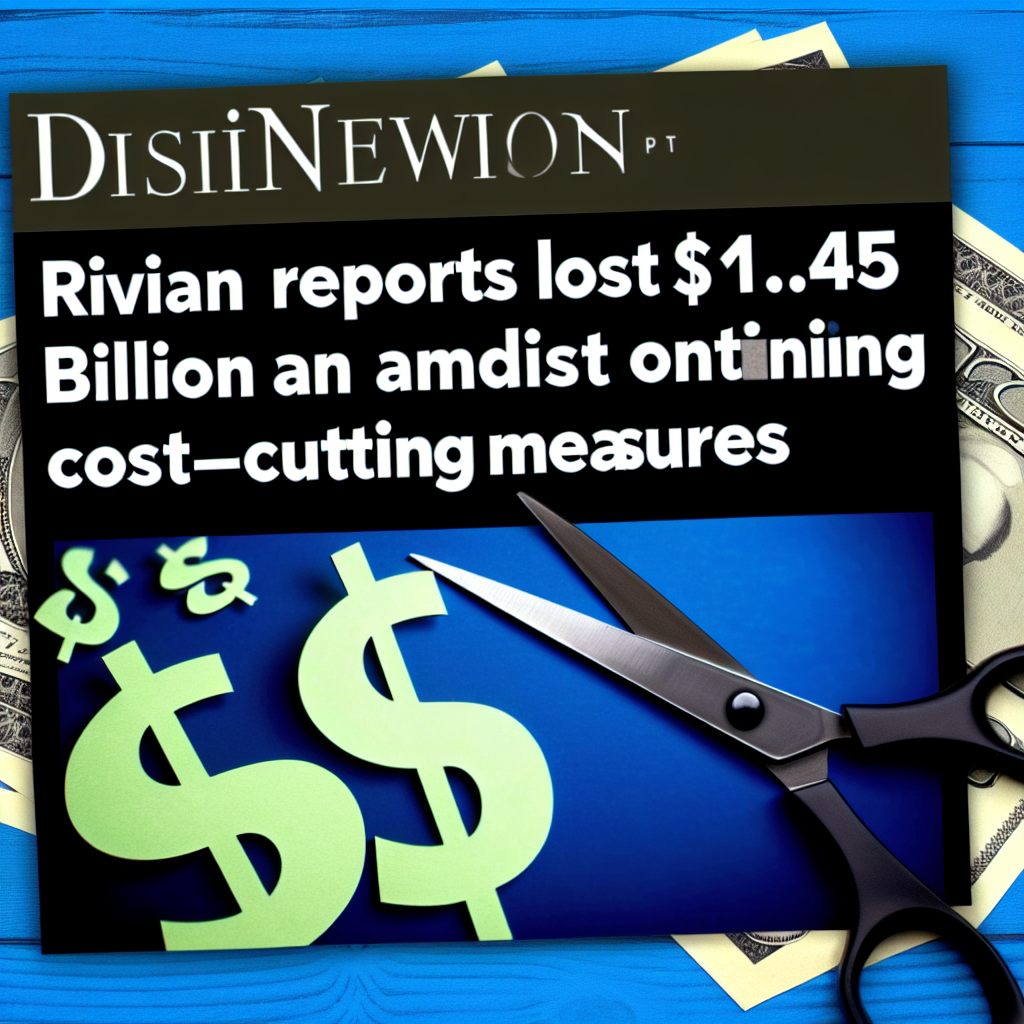Rivian’s Financial Challenges: Analyzing the $1.45 Billion Loss
Rivian, the electric vehicle startup, has recently reported a staggering loss of $1.45 billion. This significant financial setback has raised concerns about the company’s ability to navigate the competitive landscape of the automotive industry. As Rivian continues to implement cost-cutting measures, it is crucial to analyze the factors contributing to this substantial loss.
One of the primary reasons behind Rivian’s financial challenges is the high costs associated with developing electric vehicles. The research and development required to create cutting-edge technology and design innovative electric vehicles can be exorbitant. Rivian’s commitment to producing high-quality electric vehicles has undoubtedly contributed to their financial strain.
Furthermore, the COVID-19 pandemic has had a profound impact on the automotive industry as a whole. The global economic downturn caused by the pandemic has resulted in decreased consumer spending and disrupted supply chains. These factors have undoubtedly affected Rivian’s ability to generate revenue and maintain profitability.
In addition to external factors, Rivian’s ambitious expansion plans have also played a role in their financial struggles. The company has been investing heavily in building new manufacturing facilities and expanding its workforce. While these investments are essential for long-term growth, they have put a strain on Rivian’s financial resources in the short term.
To address these financial challenges, Rivian has implemented various cost-cutting measures. One of the most significant steps taken by the company is reducing its workforce. By laying off employees, Rivian aims to reduce operating costs and streamline its operations. While this decision may be necessary for the company’s financial stability, it undoubtedly has a significant impact on the affected employees and their families.
Rivian is also exploring partnerships and collaborations to alleviate its financial burden. The company has recently secured a $2.5 billion investment from Amazon, which will undoubtedly provide a much-needed boost to its finances. Additionally, Rivian has been in talks with other potential investors and strategic partners to secure additional funding and support.
Despite the significant loss, Rivian remains optimistic about its future prospects. The company has a strong lineup of electric vehicles, including the highly anticipated R1T pickup truck and R1S SUV. These vehicles have garnered significant attention and interest from consumers and industry experts alike. Rivian believes that the demand for electric vehicles will continue to grow, and they are well-positioned to capitalize on this trend.
In conclusion, Rivian’s $1.45 billion loss highlights the financial challenges faced by the company. Factors such as high development costs, the impact of the COVID-19 pandemic, and ambitious expansion plans have contributed to this significant setback. However, Rivian is taking proactive steps to address these challenges, including cost-cutting measures and securing investments and partnerships. With a strong lineup of electric vehicles and a positive outlook for the industry, Rivian remains hopeful about its future success.
Cost-Cutting Measures at Rivian: Impact on the Electric Vehicle Industry

Rivian, the American electric vehicle manufacturer, has recently reported a staggering loss of $1.45 billion. This news comes as the company continues to implement cost-cutting measures in an effort to stay afloat in a highly competitive industry. The impact of these measures on the electric vehicle industry as a whole is a topic of great interest and concern.
One of the primary cost-cutting measures that Rivian has taken is reducing its workforce. The company has laid off a significant number of employees, which has undoubtedly had a profound impact on the affected individuals and their families. However, this move is not unique to Rivian, as many companies across various industries have had to make similar difficult decisions in order to survive in the face of economic challenges.
Another cost-cutting measure that Rivian has implemented is reducing its research and development budget. This decision has raised concerns among industry experts, as research and development are crucial for innovation and staying ahead in the rapidly evolving electric vehicle market. By cutting back on these investments, Rivian may risk falling behind its competitors and losing its competitive edge.
Furthermore, Rivian has also scaled back its marketing and advertising efforts. While this may seem like a logical step to reduce costs, it can have long-term consequences for the company’s brand recognition and customer acquisition. In an industry where brand loyalty and reputation play a significant role, reducing marketing efforts could potentially hinder Rivian’s ability to attract new customers and compete with established players in the market.
The impact of Rivian’s cost-cutting measures extends beyond the company itself. The electric vehicle industry as a whole is closely watching these developments, as they could signal broader trends and challenges within the market. If Rivian, a company that was once seen as a promising player in the industry, is struggling to stay afloat, it raises questions about the overall health and sustainability of the electric vehicle market.
Additionally, Rivian’s financial struggles could have a ripple effect on other companies in the industry. Suppliers and partners who rely on Rivian’s business may also face challenges as a result of the company’s cost-cutting measures. This could lead to a domino effect, impacting the entire supply chain and potentially slowing down the growth and development of the electric vehicle industry as a whole.
In conclusion, Rivian’s recent loss of $1.45 billion and its subsequent cost-cutting measures have significant implications for the electric vehicle industry. The company’s decision to reduce its workforce, research and development budget, and marketing efforts raises concerns about its ability to compete and innovate in a highly competitive market. Moreover, the impact of these measures extends beyond Rivian, potentially affecting the entire industry and its supply chain. As the electric vehicle market continues to evolve, it is crucial for companies like Rivian to find a balance between cost-cutting measures and investments in innovation and growth. Only time will tell how these decisions will shape the future of the electric vehicle industry.
Rivian’s Future Prospects: Can the Company Recover from the Significant Loss?
Rivian, the electric vehicle startup, has recently reported a staggering loss of $1.45 billion. This news comes as the company continues to implement cost-cutting measures in an effort to stay afloat. With such a significant loss, many are questioning whether Rivian can recover and regain its footing in the highly competitive EV market.
The loss of $1.45 billion is undoubtedly a blow to Rivian’s financial stability. The company has been facing numerous challenges, including the impact of the COVID-19 pandemic on the automotive industry as a whole. The pandemic has disrupted supply chains, slowed down production, and dampened consumer demand for new vehicles. These factors have undoubtedly contributed to Rivian’s financial struggles.
However, it is important to note that Rivian is not alone in facing these challenges. Many other automakers, both traditional and electric, have also reported losses and have had to implement cost-cutting measures. The pandemic has created a difficult operating environment for the entire industry, and Rivian is just one of many companies trying to navigate through these uncertain times.
Despite the significant loss, there are reasons to believe that Rivian can recover and regain its position in the EV market. One of the company’s strengths is its strong financial backing. Rivian has secured substantial investments from major players in the industry, including Amazon and Ford. These investments provide Rivian with the necessary capital to weather the storm and continue its operations.
Furthermore, Rivian has a promising product lineup that has generated significant interest and excitement. The company’s electric vehicles, such as the R1T pickup truck and the R1S SUV, have received positive reviews for their innovative design and impressive performance. Rivian’s focus on adventure and sustainability has also resonated with consumers who are increasingly looking for environmentally friendly transportation options.
In addition to its product lineup, Rivian has also made strategic partnerships that could help propel its recovery. The company has entered into agreements with Amazon to develop electric delivery vans, tapping into the growing demand for sustainable last-mile delivery solutions. This partnership not only provides Rivian with a steady source of revenue but also positions the company as a leader in the commercial electric vehicle market.
While the road to recovery may not be easy, Rivian has shown resilience and determination in the face of adversity. The company has demonstrated its ability to adapt and make tough decisions to ensure its long-term viability. By implementing cost-cutting measures and focusing on its core strengths, Rivian is positioning itself for a comeback.
In conclusion, Rivian’s recent loss of $1.45 billion is undoubtedly a setback for the company. However, with its strong financial backing, promising product lineup, and strategic partnerships, there is reason to believe that Rivian can recover and regain its position in the EV market. The company’s ability to adapt and navigate through these challenging times will be crucial in determining its future prospects. As the automotive industry continues to evolve, Rivian has the potential to emerge as a key player in the electric vehicle space.


